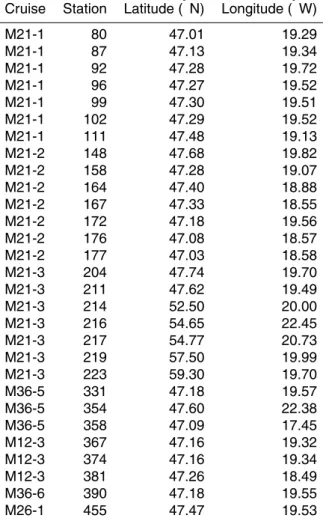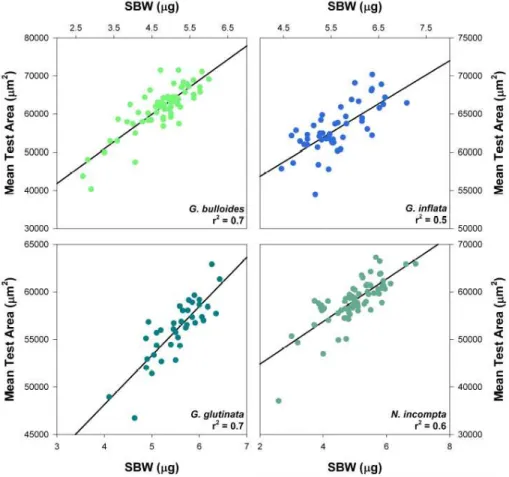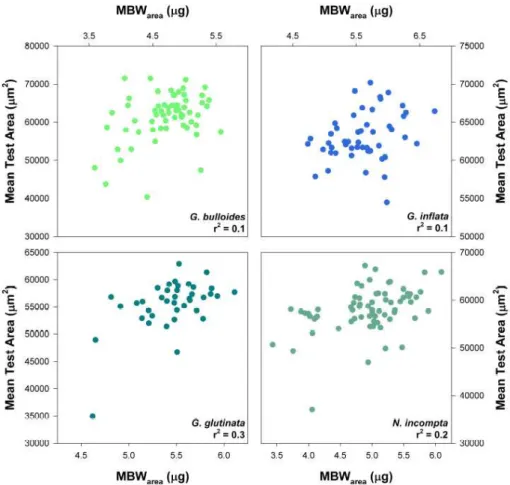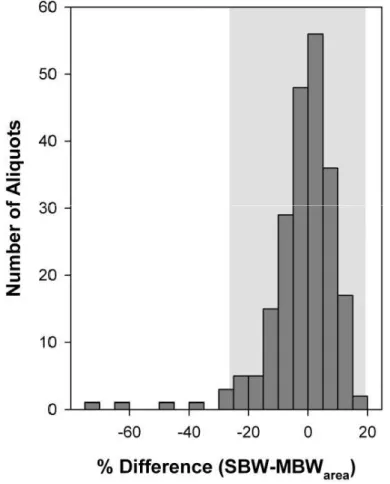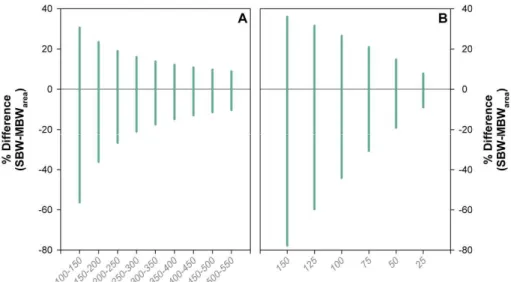BGD
7, 905–920, 2010Determining foraminiferal weight
C. J. Beer et al.
Title Page
Abstract Introduction
Conclusions References
Tables Figures
◭ ◮
◭ ◮
Back Close
Full Screen / Esc
Printer-friendly Version
Interactive Discussion Biogeosciences Discuss., 7, 905–920, 2010
www.biogeosciences-discuss.net/7/905/2010/ © Author(s) 2010. This work is distributed under the Creative Commons Attribution 3.0 License.
Biogeosciences Discussions
This discussion paper is/has been under review for the journal Biogeosciences (BG). Please refer to the corresponding final paper in BG if available.
Technical Note: Determining the
size-normalised weight of planktic
foraminifera
C. J. Beer1, R. Schiebel1,*, and P. A. Wilson1
1
National Oceanography Centre, Southampton, University of Southampton, European Way, Southampton, SO14 3ZH, UK
*
now at: Laboratoire d’Etude des Bio-indicateurs Actuels et Fossiles, Universit ´e d’Angers, 2 Boulevard Lavoisier, 49045 Angers CEDEX, France
Received: 4 December 2009 – Accepted: 1 February 2010 – Published: 3 February 2010
Correspondence to: C. J. Beer (cjb1@noc.soton.ac.uk)
BGD
7, 905–920, 2010Determining foraminiferal weight
C. J. Beer et al.
Title Page
Abstract Introduction
Conclusions References
Tables Figures
◭ ◮
◭ ◮
Back Close
Full Screen / Esc
Printer-friendly Version
Interactive Discussion
Abstract
The size-normalised weight (SNW) of planktic foraminifera, a measure of test wall thick-ness and density, is potentially a valuable palaeo-proxy for marine carbon chemistry. As increasing attention is given to developing this proxy it is important that methods are comparable between studies. Here, we compare SNW data generated using two dif-5
ferent methods to account for variability in test size, namely i) the narrow (50 µm range) sieve fraction method and ii) the individually measured test size method. Using speci-mens from the 200–250 µm sieve fraction range collected in multinet samples from the North Atlantic, we find that sieving does not constrain size sufficiently well to isolate changes in weight driven by variations in test wall thickness and density from those 10
driven by size. We estimate that these SNW data are associated with an uncertainty, or error bar, of about±11%. Errors associated with the narrow sieve fraction method may be reduced by decreasing the size of the sieve window, by using larger tests and by increasing the number tests employed. In situations where numerous large tests are unavailable, however, substantial errors associated with this sieve method remain 15
unavoidable. In such circumstances the individually measured test size method pro-vides a better means for estimating SNW because, as our results show, this method isolates changes in weight driven by variations in test wall thickness and density from those driven by size.
1 Introduction
20
The ocean contains about 38 Gt of carbon, accounting for 98% of the combined ocean-atmosphere carbon reservoir (Zeebe and Wolf-Gladrow, 2001). The size and nature of the marine carbon inventory implies that the ocean plays a significant role in determin-ing atmospheric pCO2 concentrations, and therefore global climate, from decadal to
millenial timescales (Broecker and Peng, 1982). Palaeoclimatic research has provided 25
BGD
7, 905–920, 2010Determining foraminiferal weight
C. J. Beer et al.
Title Page
Abstract Introduction
Conclusions References
Tables Figures
◭ ◮
◭ ◮
Back Close
Full Screen / Esc
Printer-friendly Version
Interactive Discussion cycle is far from complete (e.g. Archer et al., 2000; Sigman and Boyle, 2000; Peacock
et al., 2006). As anthropogenicpCO2emissions continue to alter marine carbon
chem-istry (Caldeira and Wickett, 2003; Zeebe et al., 2008), with ill-defined consequences for marine biota (Orr et al., 2005; Raven et al., 2005), there is a pressing need to better understand the operation of marine biogeochemical processes.
5
One palaeo-proxy with the potential to shed light on past changes in marine carbon chemistry is the size-normalised weight (SNW) of planktic foraminifera, which is a mea-sure of test wall thickness and density. SNW of planktic foraminifera collected from the seafloor is influenced by calcite dissolution processes, with lower SNW values indica-tive of waters with a low calcite saturation state (Ω) and low [CO23−] (Zeebe and Wolf-10
Gladrow, 2001; Broecker and Clark, 2001a). SNW was therefore originally proposed and developed as a quantitative deepwater [CO23−] proxy (Lohmann, 1995; Broecker and Clark, 2001a,b, 2003) under the assumption that, for any given species, the initial SNW is uniform in space and time. We now know, however, that the initial SNW is determined by the ambient environmental conditions during calcification (Broecker and 15
Clark, 2004). In particular, culture studies reveal that calcification rate is enhanced, and the test wall thickness and hence SNW increased, at elevated CO2−
3 concentrations
(Bi-jma et al., 1999, 2002; Russell et al., 2004). Well-preserved foraminiferal specimens collected from marine sediments have therefore been used to investigate past changes in surface water [CO2−
3 ], which, significantly, is inversely related to atmosphericpCO2
20
concentrations (e.g. Barker and Elderfield, 2002; Moy et al., 2009; de Moel et al., 2009). However, a recent analysis of the SNW-[CO23−] correlations suggests that SNW is a function of multiple, as yet undetermined, environmental controls and not [CO2−
3 ]
ex-clusively (Beer et al., 2010). Although clearly in development, SNW remains an inex-pensive, easily determined and potentially highly valuable palaeo-proxy.
25
be-BGD
7, 905–920, 2010Determining foraminiferal weight
C. J. Beer et al.
Title Page
Abstract Introduction
Conclusions References
Tables Figures
◭ ◮
◭ ◮
Back Close
Full Screen / Esc
Printer-friendly Version
Interactive Discussion cause test size can vary according to ambient environmental conditions experienced
during growth (Hecht, 1976; Schmidt et al., 2002, 2006) and therefore potentially obfus-cate the test wall thickness/density signal. Broadly speaking, size is constrained, and SNW established, using one of two methods. The simplest method with most rapid throughput involves weighing specimens picked from a narrow sieve fraction (typically 5
a 50 µm range) with the resultant data here termed the “sieve-based weight” (SBW; e.g. Broecker and Clark, 2001a). The second method is more labour-intensive and involves measuring the size of each individual test which has been picked from within a narrow sieve fraction. The test weights are then normalised to the mean measured test size to obtain a “measurement-based weight” (MBW; e.g. Barker and Elderfield, 10
2002). Ideally, weight would be normalised to the mean volume enclosed within the exterior perimeter of the test wall. This volume parameter is, however, very difficult and time-consuming to establish and alternative size parameters, such as test diameter, are typically substituted for volume.
In this study, well-preserved planktic foraminiferal specimens collected by nets from 15
the water column in the North Atlantic Ocean are employed to generate SNW estimates using both techniques on the same aliquots. Our aims are to i) quantitatively assess whether sieving satisfactorily removes the influence of size on test weight, ii) determine which of the two techniques are preferable for the estimation of SNW and iii) consider which of the test size measurements (e.g. diameter) is best used to normalise test 20
weight.
2 Methods
Foraminiferal specimens of Globigerina bulloides, Globorotalia inflata, Globigerinita glutinata and Neogloboquadrina incompta were sampled from the water column at standardised depth intervals (0–20 m, 20–40 m, 40–60 m, 40–60 m, 60–80 m, 80– 25
BGD
7, 905–920, 2010Determining foraminiferal weight
C. J. Beer et al.
Title Page
Abstract Introduction
Conclusions References
Tables Figures
◭ ◮
◭ ◮
Back Close
Full Screen / Esc
Printer-friendly Version
Interactive Discussion added to the samples in order to retard remineralisation of organic material, which
engenders carbonate dissolution, and buffered using hexamethyltetramine to a pH of 8.2. Specimens were then isolated from the sample using a pipette and dried before sieving. Only specimens ofG. bulloides that did not possess spines were employed. Specimens were delicately brush-cleaned to remove adhered material not associated 5
with the foraminifera prior to analysis.
A total of 219 aliquots from 29 locations in the North Atlantic, mainly in the vicin-ity of BIOTRANS (47◦N, 20◦E; Table 1), were used in this study. A minimum of 10
specimens (mean=19) from the 200–250 µm fraction were picked, uniformly orientated with umbilical side facing upwards and measured using an integrated, semi-automated 10
microscope and image analysis system (cf. Bollmann et al., 2004). Use of the 200– 250 µm fraction represents a compromise between the need to obtain a statistically reasonable number of tests and the desire to use large specimens and thereby obtain a sufficient aliquot mass for precision weighing. The image analysis system provides mean values for the test silhouette area and test diameter for each aliquot, where diam-15
eter is taken to be the mean of the diameters which bisect the centre of the foraminiferal test, as observed in 2-dimensions.
Following size-analysis, the tests were placed into pre-weighed aluminium capsules and transferred to an environmentally controlled weighing room. The samples were left for a minimum of 12 h to equilibrate with the ambient atmospheric moisture content 20
before being weighed (precision=0.001 mg) to obtain SBW. Samples were not oven dried before being weighed because it was found that they increased in weight during the weighing process, presumably as they absorbed moisture from the atmosphere. MBW was calculated by normalising SBW to the mean diameter (MBWdiam) and area
(MBWarea) for the corresponding species.
25
Given the large density difference between calcite (2.71 g cm−3) and wet cytoplasm
BGD
7, 905–920, 2010Determining foraminiferal weight
C. J. Beer et al.
Title Page
Abstract Introduction
Conclusions References
Tables Figures
◭ ◮
◭ ◮
Back Close
Full Screen / Esc
Printer-friendly Version
Interactive Discussion
3 Results
In Fig. 1 we show SBW against test size (area) for all four species considered in this study – in each case our data reveal a correlation between SBW and area (0.5<r2<0.7). In contrast, no such correlations are obtained between MBWarea and area (Fig. 2). Note that the weight differences observed within our dataset are quite 5
large, and are perhaps attributable to gametogenic crusts. Our data also demonstrate that SBW correlates more strongly with MBWdiam(r2=0.91;p<0.0001) than MBWarea (r2=0.67; p<0.0001; supplementary Fig. 1, see http://www.biogeosciences-discuss. net/7/905/2010/bgd-7-905-2010-supplement.pdf). In Fig. 3 we show the percentage difference between MBWarea and SBW for each aliquot. Our results show that the 10
mean difference between MBWarea and SBW is close to zero, but the standard
devi-ation is 11.3%. Overall, 23% of MBWarea values differ from their corresponding SBW
values by more than±10%.
4 Discussion
4.1 Efficacy of sieving
15
The correlations between SBW and area seen in our data (0.5<r2<0.7; Fig. 1) indicate that use of a narrow sieve fraction (200–250 µm) fails to remove the influence of test size on test weight. The maximum effect of size variations within the sieve fraction can be calculated by assuming that all the foraminifera weighed in an aliquot are either 200 µm or 250 µm in diameter, spherical in shape and effectively sieved. If all speci-20
mens were 200 µm in diameter, and normalised to the mid-point of the range (225 µm), SBW would be 27% less than MBWarea. Conversely, if all specimens were 250 µm in
diameter, SBW would exceed MBWarea by 19%. However, because foraminiferal tests
BGD
7, 905–920, 2010Determining foraminiferal weight
C. J. Beer et al.
Title Page
Abstract Introduction
Conclusions References
Tables Figures
◭ ◮
◭ ◮
Back Close
Full Screen / Esc
Printer-friendly Version
Interactive Discussion fraction used (200–250 µm), with the mean test diameter all of specimens employed in
this study being ca. 300 µm (refer to supplementary Fig. 2 and supplementary Table 1, see http://www.biogeosciences-discuss.net/7/905/2010/bgd-7-905-2010-supplement. pdf). Combined, these data reveal the inadequacy of using the 200–250 µm sieve frac-tion to constrain size variafrac-tions, and hence characterise variafrac-tions in test wall thickness 5
and density.
The finding that SBWs are in part determined by test size implies that SBW is not a good approximation of SNW. The mean difference between values of SBW and MBWarea is approximately zero, but the standard deviation (σ) is 11.3%. We take
this value (11%) to equal the error in SBW for the sieve fraction used in this study 10
(200–250 µm). Although not directly comparable because different studies use diff er-ent sieve size fractions, it is instructive to note that this error estimate is of the same order of magnitude as the change observed in some published downcore records of SNW. For example, published records describe a 20–33% change in SNW during the last deglaciation (Barker and Elderfield, 2002; de Moel et al., 2009; Moy et al., 2009), 15
a 25% change attributed to ocean acidification (de Moel et al., 2009) and a 5–20% change in SNW of foraminifera cultured over a [CO2−
3 ] range of 300–200 µmolkg− 1
(Bi-jma et al., 1999, 2002).
The use of larger specimens and a narrower sieve size window improves sieve-based estimates of SNW, as does increasing the number of specimens employed (J. Bijma, 20
personal communication, 2010). This is illustrated in Fig. 4, where the calculated po-tential difference between SBW and MBWarea is shown to decrease with the use of
larger specimens and a narrower sieve fraction window. However, reducing the size of the sieve size window reduces the number of specimens available for weighing, as does use of large specimens. Moreover, there are important pragmatic considerations. 25
BGD
7, 905–920, 2010Determining foraminiferal weight
C. J. Beer et al.
Title Page
Abstract Introduction
Conclusions References
Tables Figures
◭ ◮
◭ ◮
Back Close
Full Screen / Esc
Printer-friendly Version
Interactive Discussion generating SNW is needed.
4.2 Establishing MBW
Ideally, measurement-based weight is calculated by normalizing SBW to test volume. However, volume is very difficult to measure so must be either estimated from, or sub-stituted by, alternative parameter(s). In the absence of empirical functions linking test 5
volume to more easily measured variables, volume must be estimated by assuming that the foraminiferal test is a certain shape. An alternative approach, which avoids the use of necessarily crude approximations of the test shape, is the use of area or diam-eter to directly normalise test weight. In doing so, test diamdiam-eter, area and volume are assumed to remain proportional to one another over the size range of interest (Barker, 10
2002). Although proportionality cannot be demonstrated (because of the absence of volume measurements) the strong correlation between area and diameter (r2=0.87) lends support to the assumption of proportionality between the three measurements. Moreover, our results indicate that, unlike SBW, both MBWdiam and MBWarea do not correlate with test area (r2=0.18 andr2=0.007, respectively; supplementary Fig. 3; 15
Fig. 2) and diameter (r2=0.07 and r2=0.003, respectively; supplementary Fig. 3). This finding suggests that MBW, calculated using either area or diameter, provides a means by which variations in test wall density and thickness can be reliably charac-terised.
5 Conclusions
20
BGD
7, 905–920, 2010Determining foraminiferal weight
C. J. Beer et al.
Title Page
Abstract Introduction
Conclusions References
Tables Figures
◭ ◮
◭ ◮
Back Close
Full Screen / Esc
Printer-friendly Version
Interactive Discussion our experiment, SNW estimates based on the sieve-based method using tests from
the 200–250 µm fraction are associated with an error of ca. 11%. This source of error may be reduced by increasing the number of specimens per aliquot and by employing a smaller sieve fraction range relative to the size of the foraminifera examined. How-ever, in many circumstances this will not be practically possible because, for example, 5
too few large tests are present. In such circumstances it is preferable to employ the measurement-based method, which does not necessitate the use of numerous large specimens picked from a very narrow sieve size window, in order to characterise test wall thickness and density and thereby obtain reliable SNW estimates.
Acknowledgements. We would like to thank the reviewers for their insightful and helpful com-10
ments, which helped to improve this contribution. We in particular thank Jelle Bijma for his generous offer of data and informative review.
References
Archer, D., A. Winguth, D. Lea, and N. Mahowald: What caused the glacial/interglacial atmo-spheric pCO2cycles?, Rev. Geophys., 38(2), 159–189, 2000. 907
15
Barker, S.: Planktic foraminiferal proxies for temperature and CO2, Ph.D. thesis, University of Cambridge, 2002. 912
Barker, S. and Elderfield, H.: Foraminiferal calcification response to glacial-interglacial changes in atmospheric CO2, Science, 297(5582), 833–836, 2002. 907, 908, 911
Beer, C. J., Schiebel, R., and Wilson, P. A.: Examination of planktic foraminiferal test weight as 20
a surface water [CO2−3 ] proxy, Geology, in press, 2010. 907
Bijma, J., Spero, H., and Lea, D.: Reassessing foraminiferal stable isotope geochemistry: Imapct of the ocean carbonate system (experimental results), in: Uses of Proxies in Pa-leoceanography: Examples from the South Atlantic, edited by: Fischer, G. and Wefer, G., Springer-Verlag, Berlin Heidelberg, 489–512, 1999. 907, 911
25
BGD
7, 905–920, 2010Determining foraminiferal weight
C. J. Beer et al.
Title Page
Abstract Introduction
Conclusions References
Tables Figures
◭ ◮
◭ ◮
Back Close
Full Screen / Esc
Printer-friendly Version
Interactive Discussion Bollmann, J., Quinn, P. S., Vela, M., Brabec, B., Brechner, S., Cort ´es, M. Y., Hilbrecht, H.,
Schmidt, D. N., Schiebel, R., and Thierstein, H. R.: Automated particle analysis: Calcareous microfossils, in: Image Analysis, Sediments and Paleoenvironments, edited by: Francus, P., Kluwer Academic Publishers, Dordrecht, 229–252, 2004. 909
Broecker, W. and Peng, T.: Tracers in the Sea, Eldigo Press, New York, 1982. 906 5
Broecker, W. S. and Clark, E.: An evaluation of Lohmann’s foraminifera weight dissolution index, Paleoceanography, 16(5), 431–434, 2001a. 907, 908
Broecker, W. S. and Clark, E.: Reevaluation of the CaCO3size index paleocarbonate ion proxy, Paleoceanography, 16(6), 669–671, 2001b. 907
Broecker, W. S. and Clark, E.: CaCO3dissolution in the deep sea: paced by insolation cycles, 10
Geochem. Geophy. Geosy., 4(7), 1059, doi:10.1029/2002GC000450, 2003. 907
Broecker, W. S. and Clark, E.: Shell weights from the South Atlantic, Geochem. Geophy. Geosy., 5(3), Q03003, doi:10.1029/2003GC000625, 2004. 907
Caldeira, K. and Wickett, M. E.: Oceanography: Anthropogenic carbon and ocean pH, Nature, 425(6956), 365–365, 0028–0836 doi:10.1038/425365a 10.1038/425365a, 2003. 907 15
de Moel, H., Ganssen, G. M., Peeters, F. J. C., Jung, S. J. A., Kroon, D., Brummer, G. J. A., and Zeebe, R. E.: Planktic foraminiferal shell thinning in the Arabian Sea due to anthropogenic ocean acidification?, Biogeosciences, 6, 1917–1925, 2009,
http://www.biogeosciences.net/6/1917/2009/. 907, 911
Hecht, A. D.: An ecological model for test size variation in recent planktonic foraminifera: appli-20
cations to the fossil record, J. Foraminiferal Res., 6(4), 295–311, 1976. 908
Lohmann, G. P.: A model for variation in the chemistry of planktonic-foraminifera due to sec-ondary calcification and selective dissolution, Paleoceanography, 10(3), 445–457, 1995. 907 Moy, A. D., Howard, W. R., Bray, S. G., and Trull, T. W.: Reduced calcification in mod-ern Southmod-ern Ocean planktonic foraminifera, Nature Geosci., 2(4), 276–280, 1752–0894, 25
doi:10.1038/ngeo460, 2009. 907, 911
Orr, J. C., Fabry, V. J., Aumont, O., Bopp, L., Doney, S. C., Feely, R. A., Gnanadesikan, A., Gruber, N., Ishida, A., Joos, F., Key, R. M., Lindsay, K., Maier-Reimer, E., Matear, R., Mon-fray, P., Mouchet, A., Najjar, R. G., Plattner, G. K., Rodgers, K. B., Sabine, C. L., Sarmiento, J. L., Schlitzer, R., Slater, R. D., Totterdell, I. J., Weirig, M. F., Yamanaka, Y., and Yool, A.: 30
Anthropogenic ocean acidification over the twenty-first century and its impact on calcifying organisms, Nature, 437(7059), 681–686, 2005. 907
BGD
7, 905–920, 2010Determining foraminiferal weight
C. J. Beer et al.
Title Page
Abstract Introduction
Conclusions References
Tables Figures
◭ ◮
◭ ◮
Back Close
Full Screen / Esc
Printer-friendly Version
Interactive Discussion the generalized glacial-interglacial cycle, Global Biogeochem. Cy., 20(2), GB2010,
doi:10.1029/2005GB002448, 2006. 907
Raven, J., Caldeira, K., Elderfield, H., Hoegh-Guldberg, O., Liss, P., Riebesell, U., Shepherd, J., Turley, C., and Watson, A.: Acidification due to increasing carbon dioxide, Tech. rep., The Royal Society, 2005. 907
5
Russell, A. D., H ¨onisch, B., Spero, H. J., and Lea, D. W.: Effects of seawater car-bonate ion concentration and temperature on shell U, Mg, and Sr in cultured plank-tonic foraminifera, Geochimica et Cosmochimica Acta, 68(21), 4347–4361, 0016–7037 doi:10.1016/j.gca.2004.03.013, 2004. 907
Schiebel, R., Barker, S., Lendt, R., Thomas, H., and Bollmann, J.: Planktic foraminiferal disso-10
lution in the twilight zone, Deep Sea Res. II, 54, 670–686, 2007. 909
Schmidt, D., Renaud, S., Bollmann, J., and Thierstein, H.: Environmental dependence of size in planktic foraminifers, Geochim. Cosmochim. Ac., 66(15A), A680–A680, suppl. 1, 2002. 908
Schmidt, D. N., Lazarus, D., Young, J. R., and Kucera, M.: Biogeography and evolution of body 15
size in marine plankton, Earth-Sci. Rev., 78(3–4), 239–266, 2006. 908
Sigman, D. M. and Boyle, E. A.: Glacial/interglacial variations in atmospheric carbon dioxide, Nature, 407(6806), 859–869, 2000. 907
Zeebe, R. and Wolf-Gladrow, D.: CO2 in Seawater: Equilibrium, Kinetics, Isotopes, Elsevier Oceanography Series, vol. 65, Elsevier, 2001. 906, 907
20
BGD
7, 905–920, 2010Determining foraminiferal weight
C. J. Beer et al.
Title Page
Abstract Introduction
Conclusions References
Tables Figures
◭ ◮
◭ ◮
Back Close
Full Screen / Esc
Printer-friendly Version
Interactive Discussion
Table 1.Locations of multinet sampling stations in the North Atlantic.
Cruise Station Latitude (◦N) Longitude (◦W)
M21-1 80 47.01 19.29
M21-1 87 47.13 19.34
M21-1 92 47.28 19.72
M21-1 96 47.27 19.52
M21-1 99 47.30 19.51
M21-1 102 47.29 19.52
M21-1 111 47.48 19.13
M21-2 148 47.68 19.82
M21-2 158 47.28 19.07
M21-2 164 47.40 18.88
M21-2 167 47.33 18.55
M21-2 172 47.18 19.56
M21-2 176 47.08 18.57
M21-2 177 47.03 18.58
M21-3 204 47.74 19.70
M21-3 211 47.62 19.49
M21-3 214 52.50 20.00
M21-3 216 54.65 22.45
M21-3 217 54.77 20.73
M21-3 219 57.50 19.99
M21-3 223 59.30 19.70
M36-5 331 47.18 19.57
M36-5 354 47.60 22.38
M36-5 358 47.09 17.45
M12-3 367 47.16 19.32
M12-3 374 47.16 19.34
M12-3 381 47.26 18.49
M36-6 390 47.18 19.55
BGD
7, 905–920, 2010Determining foraminiferal weight
C. J. Beer et al.
Title Page
Abstract Introduction
Conclusions References
Tables Figures
◭ ◮
◭ ◮
Back Close
Full Screen / Esc
Printer-friendly Version
Interactive Discussion Page 1/ 1
Fig. 1. The mean sieve-based test weight (SBW; µg) versus the mean test area (µm2)
for aliquots of planktic foraminifera sampled using a multiple-opening-closing net in the North Atlantic Ocean picked from the 200–250 µm sieve fraction. The correlations observed
(0.5<r2<0.7; p<0.0001) suggest that typically “narrow” sieve fractions provide an insufficient
BGD
7, 905–920, 2010Determining foraminiferal weight
C. J. Beer et al.
Title Page
Abstract Introduction
Conclusions References
Tables Figures
◭ ◮
◭ ◮
Back Close
Full Screen / Esc
Printer-friendly Version
Interactive Discussion Page 1/ 1
Fig. 2. Measurement-based weight (MBWarea; µg) versus test area (µm2) for each of the
BGD
7, 905–920, 2010Determining foraminiferal weight
C. J. Beer et al.
Title Page
Abstract Introduction
Conclusions References
Tables Figures
◭ ◮
◭ ◮
Back Close
Full Screen / Esc
Printer-friendly Version
Interactive Discussion Page 1/ 1
Fig. 3. The difference between “sieve-based weight” (SBW) and area-normalised weight
BGD
7, 905–920, 2010Determining foraminiferal weight
C. J. Beer et al.
Title Page
Abstract Introduction
Conclusions References
Tables Figures
◭ ◮
◭ ◮
Back Close
Full Screen / Esc
Printer-friendly Version
Interactive Discussion
Page 1/ 1
Fig. 4. (A)The theoretical minimum and maximum percentage difference between SBW and
